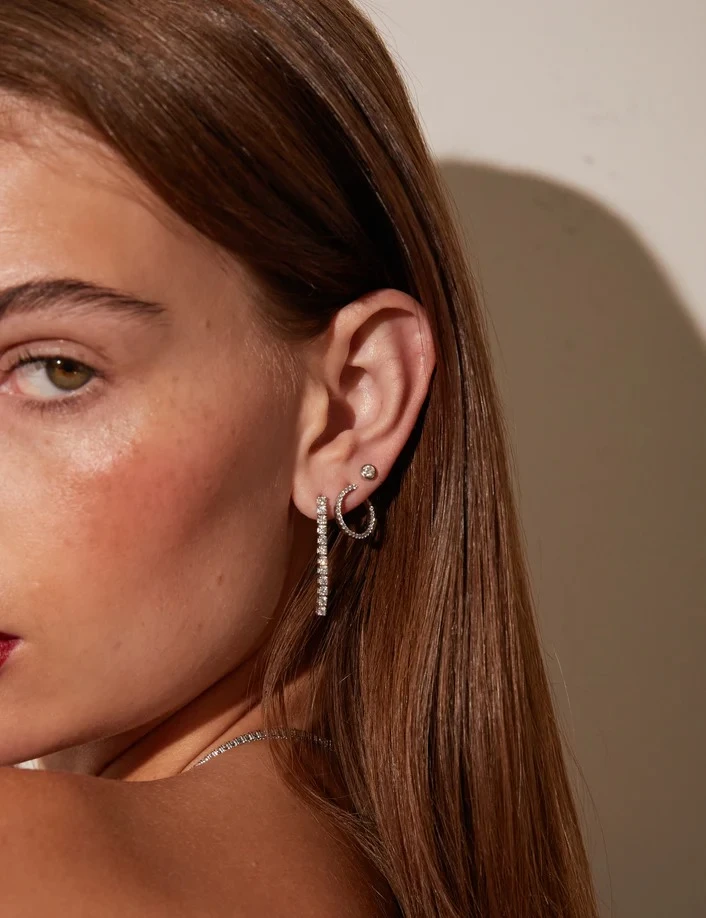
Jewelry Trends
•04 min read
The world of ear rings extends far beyond traditional pierced options. Whether you're avoiding piercings altogether, letting healed piercings rest, or simply seeking versatility in your jewelry collection, non pierced ear rings offer endless possibilities for self-expression without commitment.
From boardroom meetings to weekend brunches, these innovative designs prove that style never requires compromise. The key lies in understanding your options and knowing what to look for in quality construction and comfort.
Clip on earrings remain the gold standard for non pierced options. Modern versions have evolved significantly from the pinchy designs of decades past. Look for adjustable tension mechanisms that distribute pressure evenly across your earlobe.
Quality clip on earrings feature padded contact points and ergonomic design. The best versions allow you to adjust tension for all-day comfort. Consider your face shape when selecting: elongated drops suit round faces, while wider studs complement angular features.
Magnetic earrings use powerful rare earth magnets positioned on both sides of your earlobe. The front displays your chosen design while the back magnet remains invisible. This creates the illusion of traditional pierced earrings.
These work exceptionally well for smaller, lighter designs. Stud styles and delicate drops translate beautifully to magnetic construction. However, avoid magnetic options for statement pieces or heavy materials that might overwhelm the magnetic hold.
Modern jewelry design has revolutionized how we think about ear adornment. Ear cuffs wrap around your ear's natural curves without requiring any fastening mechanism. They stay secure through their curved design and gentle spring tension.
Ear climbers create vertical interest along your earlobe, often extending upward in cascading or geometric patterns. Ear jackets frame traditional studs with decorative elements that peek out behind or around the earlobe.
Pro Tip: Weight Distribution
The most comfortable non pierced earrings distribute weight evenly. Look for designs where the visual weight matches the actual weight—heavy-looking pieces should feel substantial, while delicate designs should be genuinely lightweight.
Ear crawlers follow your ear's natural contours, creating the illusion of multiple piercings. These work particularly well in precious metals where the material quality ensures both comfort and durability.
Quality materials make the difference between earrings you'll reach for daily and ones that collect dust. Solid gold, sterling silver, and high-grade alloys resist tarnishing and skin irritation. Avoid nickel-containing metals that can cause allergic reactions.
Look for smooth contact points where the earring touches your skin. Rough edges or poor finishing will become uncomfortable quickly. Quality construction includes proper polishing and attention to every surface that might contact your ear.
Start with smaller designs and work up to statement pieces. Your ears need time to adjust to wearing non pierced earrings, especially if you're new to them. Begin with lightweight options for shorter periods.
Consider your daily activities when selecting size. Larger ear cuffs might catch on clothing or hair during active days. Reserve dramatic ear climbers for occasions where you can be mindful of their presence.
Many quality non pierced earrings offer adjustment options. Clip mechanisms should open and close smoothly without feeling loose or overly tight. Test the adjustment range before committing to a purchase.
Ear cuffs and climbers often allow for subtle reshaping to match your ear's unique contours. Gentle adjustments using jewelry pliers can personalize the fit, but always work slowly and carefully to avoid damage.
Workplace-appropriate non pierced earrings strike a balance between polished and understated. Small hoops, classic studs, and minimal ear cuffs translate well to professional environments. Stick to precious metals and avoid overly trendy or dramatic designs.
Invisible earrings—minimal magnetic or clip options that create subtle sparkle—work particularly well for conservative dress codes. These provide just enough interest without drawing unwanted attention.
Special events call for non pierced earrings with presence. Statement ear jackets transform simple studs into occasion-worthy pieces. Dramatic ear crawlers create red-carpet glamour without requiring multiple piercings.
Layer different styles for maximum impact. Combine a delicate ear cuff with coordinating ear pins or mix metals for contemporary appeal. The key is maintaining balance and ensuring all pieces work harmoniously together.
Build a collection that transitions seamlessly from morning meetings to evening plans. Quality clip on earrings in classic styles serve as your foundation pieces. Add ear wraps for weekend casualness and ear charms for personality.
Consider pieces that work alone or in combination. Modular designs let you create different looks with the same components, maximizing your investment.
Clean non pierced earrings regularly with appropriate methods for each material. Precious metals benefit from gentle polishing cloths, while delicate mechanisms require careful cleaning around moving parts.
Store earrings properly to maintain their shape and function. Clip mechanisms can weaken if left compressed, so store them in their natural position. Keep magnetic earrings away from other magnets or magnetic-sensitive items.
Handle adjustable elements carefully. Over-bending can weaken metal and compromise fit. Make small adjustments gradually rather than forcing dramatic changes.
Rotate your collection to prevent wear patterns. Even the most comfortable earrings benefit from occasional breaks, especially during sleep or exercise.
A: Most people comfortably wear quality non pierced earrings for 8-10 hours. Start with shorter periods and gradually increase wear time as your ears adjust.
A: Modern magnetic earrings use localized magnetic fields that don't typically affect phones or hearing aids, but consult your device manufacturer if you have concerns.
A: Yes, especially magnetic earrings and well-fitted clip styles. The key is selecting appropriate sizes and ensuring proper positioning on your ear.
A: Most ear cuffs work for various ear shapes, but some adjustment may be needed. Look for styles with gentle curves that follow natural ear contours.
A: Ensure proper fit, clean contact points regularly, and choose appropriate weights for your ear size. Some people find that slightly textured contact pads help maintain grip.


Item removed